Contents
Flowerbeds designed in one color are now not uncommon, and compositions with yellow flowers are very popular at all. Maybe because yellow flowers are very diverse, or maybe yellow is so popular because it is associated with warmth and the sun. Yellow perennial flower beds in the country personify the refined taste of the owners, make the site cheerful and bright. And so that the flower bed does not look monotonous, you need to plant perennials of different shades on it.
Options for creating yellow flower beds
Perennial flowers in one tone are the most original and modern solution for a garden and a summer cottage, especially if this color is yellow. Before proceeding with the creation of such a mono-flower, it is necessary to determine the size and shape of the composition, since the number and location of plants depend on this. If you are going to break up a perennial mixborder in the country, then yellow perennials of 3-5 varieties will look most successful, differing in the tone of the inflorescences: lemon, orange, bright with a contrasting middle. It is very important to plant flowers of different shades and heights – in this case, the composition will not merge.

For a mixborder, you should choose one tall perennial, 2-3 plants of medium height, and undersized perennials for the foreground. When creating a spring flower bed, the center of the composition can be occupied by yellow tulips or forsythia (yellow perennial ornamental shrub), along the very edge of primrose or crocus, between them are daffodils.
For a summer flower bed, you can use the following yellow flowers: rudbeckia, chamomile, gelenium, perennial sunflower, yellow stonecrop, cinquefoil as a background. We should not forget about decorative deciduous and evergreen crops – greens well shade yellow. In a regular-shaped flowerbed, tulips look great against the background of crocuses, or irises against the background of stonecrops, since these pairs are contrasting in height. When forming a flower bed of 5 or more species, the flowers are planted so that the high ones are in the center (depth) of the composition, and the undersized perennials are along the edge.
The center of a regular (correct) flower bed can be occupied by such perennials as elecampane, the same rudbeckia, undersized perennials can be planted along the edge: adonis, sedum, between them – chamomile. Perennial daisies in temperate climates are most often planted in the country. And this is no accident – garden daisies are unpretentious, diverse, bloom for a long time and are capable of self-seeding.
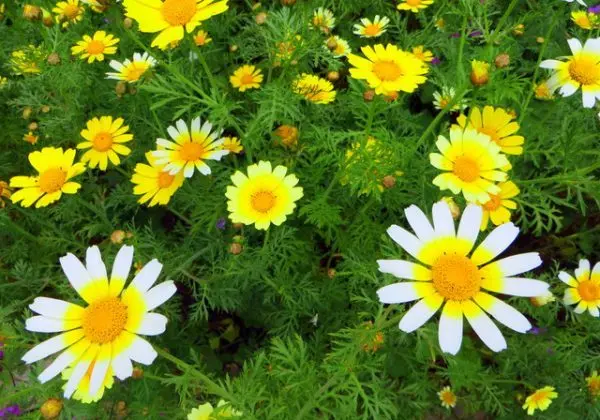
Video “Yellow perennials in the country”
Video selection of various decorative yellow flowers.
yellow perennials
Perennial flowers are very diverse. Each perennial species contains cultivars with yellow flowers. Clematis, roses, lilies, gladioli are perennials that bloom in completely different shades, including yellow, and everyone knows about it.
But there are perennial flowers that are only yellow (forsythia, goldenrod), as well as little-known perennials that live in the wild, but are often used for the garden. To create a monochromatic flower bed, the following yellow perennials are best suited.
- Adonis. A perennial herbaceous plant growing wild, but under favorable conditions it can grow in the garden. The flower belongs to undersized crops – its height is 20-30 cm, loves loose fertile soil, can grow in one place for more than 10 years.
- Crocus. A low-growing bulbous perennial that blooms in early spring, when the snow has not yet melted. It does not like acidic and waterlogged soils, growing in one place for more than 4 years, it begins to grow smaller and degenerate, so this herbaceous perennial plant needs to be replanted periodically.
- Primrose. The name is often associated with miniature potted decorations. But in fact, primrose is a very winter-hardy perennial, reaching a height of 30-40 cm, and often used to decorate the garden. If you plant a perennial flower in a sunny place, it will delight with itself from the beginning of April to the end of June.
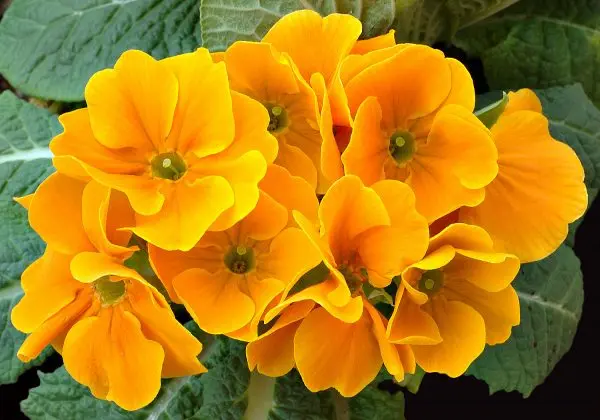
- Tulip. The most popular garden perennial. Likes sun, rich soil and regular watering. In one place, a perennial flower can grow 3-4 years. Warbler, Apollo, Aga Khan, Berlioz are very decorative and unusual yellow perennial varieties.
- Narcissus. An unpretentious herbaceous perennial plant of the bulbous family. Without a transplant, it can grow up to 6 years, loves loose soil and phosphorus-potassium fertilizers. Erlicheer, Clear Day, Martinette are the names of the most lush (terry) varieties.
- Iris. This yellow perennial is the most frequent guest of front gardens and the decoration of every dacha. The flower is completely unpretentious, grows well in moist soil, in the shade of the garden, does not need to be transplanted for more than 7 years. Spectral Challenge is the name of the most popular variety.
- Doronicum. A perennial herbaceous plant with daisy-like flowers. It grows very fast and tolerates shade well. Garden doronicum, reaching a height of 1 m, is prone to lodging, and therefore needs to be tied up.
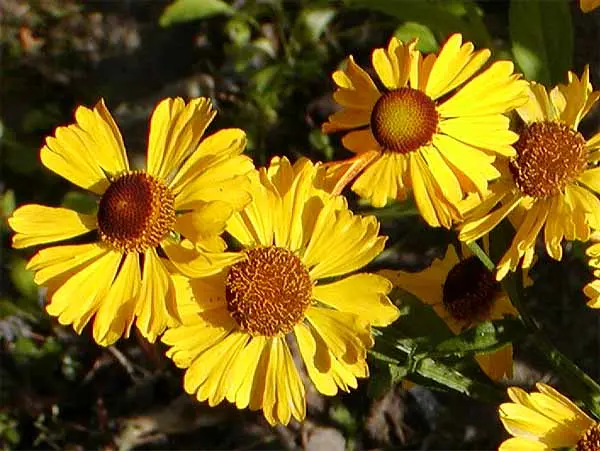
- Helenium. Perennial yellow flower, similar in appearance to daisies. Likes moist calcareous soil, rainy and cloudy weather. Garden types of gelenium reach a height of up to 1,5 m, and bloom from August until frost.
- Goldenrod (solidago). An unpretentious perennial with small yellow flowers collected in long brushes. Very resistant to pests, responsive to any mineral dressing. Garden goldenrod needs watering and weeding only in the first year of life.
- Heleopsis. Perennial garden daisies with yellow or brown centers. The flower is not picky about the soil, but does not like excessive moisture, it easily propagates from seeds. Heliopsis Spitzeniazerin is a perennial variety with lush double flowers.
- Buzulnik. A herbaceous perennial plant, garden species of which grow to a height of 1,5-1,8 m. The flower loves moist soil, feels great in the partial shade of the garden, can grow up to 20 years without a transplant. These perennial flowers are propagated by seeds and division of the rhizome.
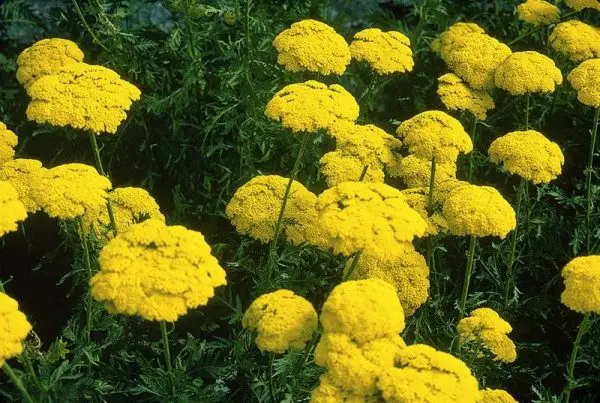
- Yarrow. An unpretentious perennial that can grow in the most unexpected places on poor and stony soil. Despite the fact that the flower is wild and medicinal, flower growers have found a worthy use for it in flower beds, since among the yarrows there are also undersized, very compact varieties.
- Rudbeckia. The most popular perennial daisies with terry dissected petals, and yellow or black centers. It is not demanding on the soil, suitable for summer cottages with sandy soil, blooms from late June to late August, propagated by seedlings and seeds.
- Chilean gravel. Herbaceous perennial plant with bright yellow double flowers. Likes sun and moisture, but can also grow in partial shade gardens and tolerate drought. For the winter, gravel is recommended to be cut and covered.
- Ranunculus (garden buttercups). Very beautiful perennial with lush and large flowers. Likes loose, humus-rich soil and sunny areas. Propagated by tubers that need to be dug up for the winter.

- Gentian is yellow. A perennial wild herbaceous plant, reaching a height of 1 m. It loves moist and acidic soil, but it is quite difficult to breed it in the country. Gentian has a long tap root, so it can only be transplanted in the first two years.
- Oenothera. A perennial, more precisely a biennial herbaceous plant that grows well on poor calcareous soils. The garden variety of evening primrose reaches 1,5 m, but there are also perennial ground cover varieties that can be used for mixborders, alpine slides, and rocky summer cottages.
- Snapdragon. Herbaceous perennial plant with small flowers collected in long “heads”. The culture loves fertile loose soil, the sun, but also grows well in the country in partial shade. If you feed and remove dried flowers in time, snapdragons will bloom from June to the end of October. Of the caring measures, it needs only watering as the soil dries out, and phosphorus-potassium top dressing.
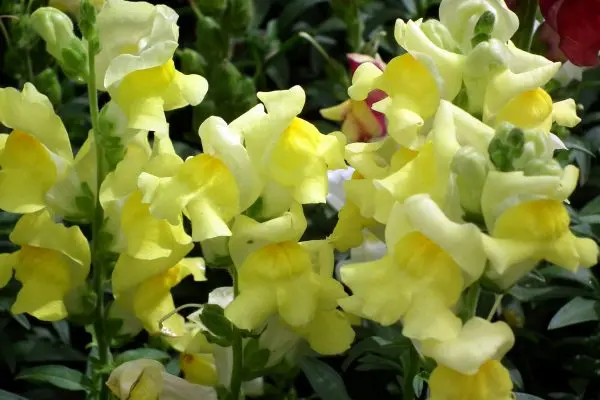
- Stonecrop (sedum). Low-growing ground cover perennial, pleasing with itself from July until the first frost. It is a perennial compact bush with multi-colored, but more often yellow small flowers. It can grow in dry soil, feels good on alpine hills, rocky areas of the country house.
- Eremurus. Tall (up to 2 meters) herbaceous perennial plant with small flowers that make up spike-shaped brushes. The culture loves loose drained soil, rather capricious: it often freezes or dies from moisture.
- Stock rose (mallow). Very tall (up to 2 m) herbaceous perennial with luxurious inflorescences located on long stems. The flower is ideal for the background of a mixborder, decorating fences, walls. Easily tolerates drought, not demanding on the soil, propagated by seeds.
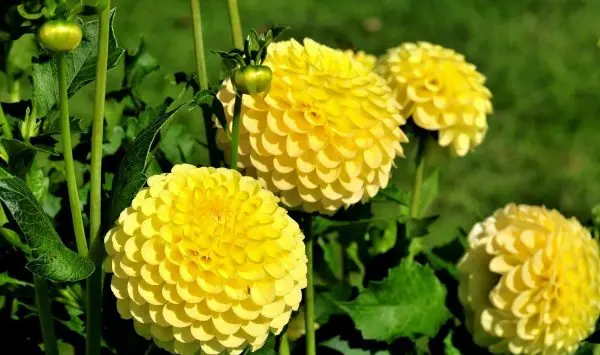
- Dahlia. Garden perennial tuberous flower, preferring sunny areas with fertile loamy soil. For the winter, dahlia tubers need to be dug up and stored in dry rooms. These perennials can have single-row or lush flowers, and vary in height (from 30 cm to 1,2 m). Large and tall varieties need support. Sunny Boy, Funny Face, Mister Sandman, Cambridge are the names of the most magnificent dahlias.
Video “Yellow garden flowers”
This video will help you decide on the choice of variety for your flower bed.
Author: Svetlana Galitsina
Loading…









